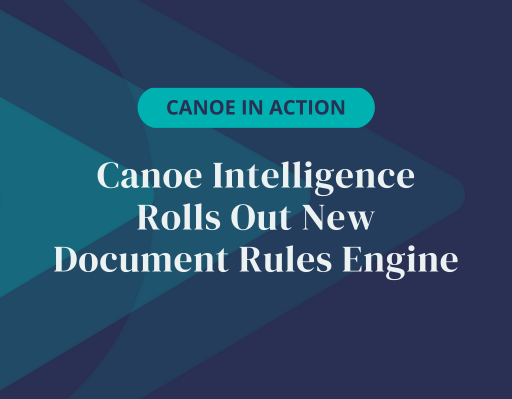How Canoe’s New Document Rules Engine Helps Clients Automate Workflows

Flag and review vital investment documents with greater efficiency
This past February, we released our newest enhancement to the Canoe Intelligence platform, the Document Rules Engine. Developed in collaboration with several beta clients, the Document Rules Engine is another addition to Canoe’s toolkit of solutions that automate time-consuming, manual workflows.
Now available for all users of the Canoe platform, the Document Rules Engine enables you to create custom rules that can be triggered for certain document types, for a specific set of funds.
“The tool can actually be used in both directions,” explained Kevin Tobiassen, Director, Product Management at Canoe. “Our clients may want to tag documents that they receive period over period. For example, a client may feel that a certain set of documents does not need to be reviewed in great detail. They have confidence in the data within those documents, so they can then apply a tag that pushes those documents straight through, indicating no review is needed. On the other hand, if there are funds that do not report consistently, or if they have found that there are documents that generally should be reviewed more before they’re pushed downstream, the client can apply a general ‘Needs More Review’ tag or create a specific rule dedicated to that document.”
Users can add as many rules as they wish, edit existing rules, and delete them from the same interface. The Document Rules Engine ultimately provides Canoe clients with more automation and flexibility, by giving the ability to tag specific documents, flag them for review, or automatically approve them for straight-through processing without any manual intervention. These rules-based automations ultimately allow users to more efficiently allocate resources and time.
“We are always looking for places to further automate our clients’ workflows,” said Tobiassen. “The idea for the Document Rules Engine was inspired by conversations with clients—listening to what people were asking for—and also by looking through the data to identify certain processes that clients were doing manually, month over month or quarter over quarter,”
Following these conversations, Tobiassen brought together a pod of developers to start fleshing out this enhancement. Taking a collaborative approach, he brought clients into the pod as beta users to provide feedback and validation before enabling the Document Rules Engine for the broader Canoe client base of more than 300 firms spanning family offices, wealth managers and institutional investors and allocators.
“Early on in development, we found 5 clients across family offices, institutional investors, and wealth managers who wanted to be the initial testers,” said Tobiassen. “We worked closely with those clients to develop the initial version, which had some tagging options and was dedicated to only one document type. Once we released that beta, we then continued to test it with those clients for additional feedback. Originally, we focused on approval status, but we expanded to cover additional actions such as document tagging and commenting, based on client needs.”
Canoe has already received invaluable feedback from clients while developing this enhancement, but Tobiassen believes it will only continue to improve. Looking forward, he hopes Canoe can expand the Document Rules Engine even further to help teams that have manual workflows.
“This will be especially beneficial in reducing manual review workflows for many clients,” he said. “It will support operations teams, and even smaller firms that don’t have operations teams. Now, clients can have documents go straight through with even more confidence.”
Looking forward, users can expect further automations from the Document Rules Engine, as Tobiassen looks for ways to expand upon the document types and rules.
“Right now, the definitions are based on document type and fund,” explained Tobiassen. “But there’s demand to create rules for specific entities or specific allocations. Then expand further to define the actions taken once a document is flagged in the system and what happens with the document when a rule is triggered. That’s the type of feedback that we’re working on next to expand this new engine.”
Tobiassen is excited to continue developing these features and hopes that clients find value in the product’s new abilities.
“Hopefully it reduces manual burden even further for our clients,” ends Tobiassen. “Enabling our clients with 100% confidence in their data while achieving full workflow automation are two of Canoe’s main goals right now. This engine perfectly feeds into those goals.”